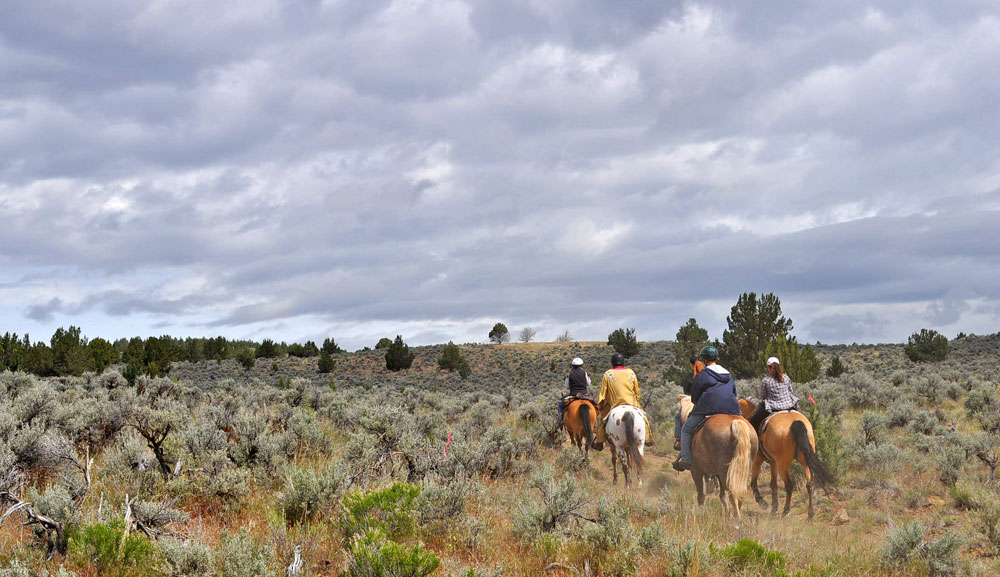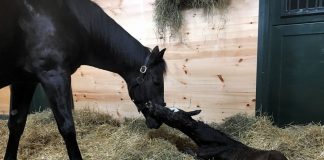
American Competitive Trail Horse Ride by Bureau of Land Management Oregon and Washington via flickr/CC BY 2.0
These training tips and exercises will do wonders for your horse’s strength, balance, and confidence so you both can have the best possible ride.
1. Brain Check
Before you head out, take note of your horse’s state of mind. Calmness is essential for your horse to process and retain information. If he’s fidgety, calling to his friends, or frozen in fear, help him relax. Try taking him for a walk, asking that he lower his head, or track leisurely circles on a longeline or under saddle. Choose whatever works best to help your horse feel secure and have a positive experience.
2. Warm Up
Limber your horse with a 10 to 15 minute walk on a loose rein. Ask him to lower and extend his neck to stretch his spine.
Establish fluid and supple rein contact with your hands held slightly wider than your hips and low in front of the saddle. Add leg at the girth (both legs if traveling in a straight line, or your inside leg if you’re riding an arc) to soften his body if he stiffens, shortens his stride, or offers resistance.
Let the reins slip through your fingers so he can stretch freely. Then move up to a slow, relaxed trot or gait on a loose rein for two to five minutes. Next, ask for more extension for a few minutes to encourage your horse to reach through the shoulders and hips.
Finally, return to the walk in a long and low frame. Conclude the warmup with a series of walk-trot-walk, walk-stop-back transitions to engage his hindquarters and supple his back and loin.
3. Ride Right
An imbalance in your position, even a slight one, will cause an imbalance in your horse.
Ride with your spine erect, relaxed, and perpendicular to your horse’s spine. Sit evenly over both seat bones. Adjust your stirrups so you have some bend in your knee. Hold your heels directly under your hip bones and slightly lower than your toes. Line up your chin with the center of your horse’s body (even when riding curved paths and turns). Keep your eyes soft and focused on the road ahead.
4. Balance Point
The way your horse carries himself means the difference between comfort, pain and strain, or injury. Discomfort and tension caused by imbalance also causes emotional stress that can lead to behavioral problems.
To avoid these issues, ask your horse to travel with his weight evenly distributed from side to side (lateral balance) and engage his hind end (horizontal balance). Lateral balance is created by supporting your horse with soft, even rein contact.
He should feel the same amount of pressure (whether slack or taut) on both sides of his mouth. If one rein is tighter than the other, he will lean away from or toward the pressure and overload the corresponding foreleg.
Your horse may not be able to keep his spine very straight at first, so ask him to do what he can, then let him rest. If staying straight continues to be a struggle, he isn’t strong, supple or symmetrical enough. Help him develop straightness with lateral bending exercises (tip No. 5).
Lateral bending also lays the groundwork for hind end engagement, the cornerstone of horizontal balance. To understand horizontal balance, ride your horse down a hill. If he shifts his weight back and controls his descent, he is engaging his hindquarters and they are strong enough to support him.
If he gains speed, leans against your hands, or you’re unable to slow him down, he is carrying his weight on the forehand. This puts excessive strain on the forelimbs, causes emotional stress (no horse enjoys feeling unbalanced), increases the risk of a fall, and limits your control.
On level or sloped ground, rebalance your horse and engage his hindquarters by shortening your reins until you can lightly feel his mouth in your fingertips. Then with both hands slightly in front of the saddle, hold one rein steady while you turn your opposite hand palm up.
In rhythm with his stride, pulse your pinky finger against the rein at an angle toward your horse’s withers. If after three or four seconds there is no change, increase the pressure slightly.
When his weight shifts rearward, you will feel a lightening of the reins, a slowing of his stride, and a momentary compression of his gait, which with practice he will maintain for longer periods of time. Anytime you feel that wonderful rearward shift of balance and energy, quiet your hand and reward your horse with verbal praise and withers scratches.
5. Curve Control
Bending is invaluable for developing strength, suppleness, and lateral/horizontal balance. You can bend your horse anywhere the trail curves, but weaving in and out of trees is an excellent way to practice this exercise.
Shorten your inside rein and touch your horse at the cinch with the calf of your inside leg until he flexes his spine. The degree of bend is created by the length of your reins and dictated by the path you’re following—your horse’s body conforming to the size and shape of the arc. It’s also important to maintain a consistent pace as your horse enters, executes, and exits a bend. A slowing or shortened stride is a sign of lost lateral and horizontal balance that can easily be restored with a few encouraging squeezes from your legs.
6. Ride to the Side
Lateral moves increase your horse’s responsiveness, agility and coordination. Use shoulder-in to rebalance him and activate/strengthen his inside hind leg. It can be performed on any straight section of trail.
Simply flex him slightly in one direction as though you are preparing for a turn, letting his shoulders begin to step into that direction. Turn your shoulders slightly that way too. Then gently push him forward down the trail with your inside leg (the leg he is flexed toward) at the girth while his shoulders continue to stay shifted to the inside of the path.
The leg-yield (moving forward and to the side on a diagonal line) increases your horse’s responsiveness to your leg, increases the reach of his shoulders, and activates his inside hind leg. Hold your reins evenly and make light contact with your horse’s mouth. Slide your outside leg forward toward his shoulder and move him over with your inside leg in the middle of his ribcage.
7. Level the Field
Arena riding is a chance to exercise your horse’s body away from the asymmetrical terrain he encounters on trail.
Ride in extended gaits to elongate his frame and increase range of motion. Use circles and changes of direction to increase balance and flexibility. Ask for downward transitions and collected work to build strength in her hindquarters and loin. Spending two days per week on a flat surface with safe footing will do wonders to enhance and maintain your horse’s physique.
DALE RUDIN is a CHA-certified riding instructor and clinician with a mindful and balanced approach to horsemanship and riding. www.un-naturalhorsemanship.com
This article originally appeared in the August 2017 issue of Horse Illustrated magazine. Click here to subscribe!






